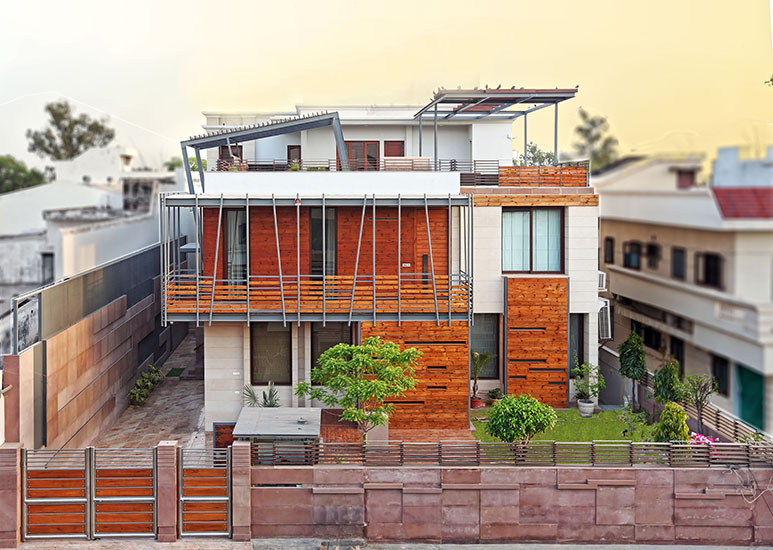![CH[11] | Image © AKDA](https://hawmagazine.com/wp-content/uploads/2013/06/CH11.jpg)
Project Name: Cuboid House, New Delhi
Architectural Group: Amit Khanna Design Associates (AKDA)
Architect: Amit Khanna
Project Location: New Friends colony, New Delhi, India
Project Type: Residential
Project Completion Year: 2012
Project Area (Total): 4500 Sq.Ft / 418 Sq. M
Built-Up Area: 15000 Sq.Ft / 1394 Sq. mt
Structural: Space Consulting Engineers
Mechanical: Space Consulting Engineers
Civil: Space Consulting Engineers
HVAC: Daikin
PMC: Kriti Buildwell
Image Courtesy: Amit Khanna Design Associates (AKDA)
Text: Amit Khanna Design Associates (AKDA)
Developer-driven apartment blocks have completely overtaken the immediate context and most of urban Delhi. These apartment blocks typically occupy the complete permissible envelope and then embellish the peripheral walls with whatever is currently most fashionable. The resulting urban condition is one dominated by forced facades that are 50ft/15m tall, punctuated only with unusable three feet balconies and large expanses of inoperable glass with little or no protection from the climate.
In contrast, the Cuboid House strategically optimises all of the area permissible by local code, but redistributes it amongst the various floor levels.
The lower service floors are extended to the perimeter to allow for a larger ground floor and to maximise the parking at the road level. However instead of stacking upper plans above each other, the building steps away dramatically as it rises, giving way to a series of decks that open up to views on the north-east.
This strategy helps bring light deep into what is essentially, a narrow thin building.
To further add to the luminosity of the interior spaces, two light wells are placed in the main living space. Equipped with operable windows, they not only bring light, but also draw out air from the floors and vent from the terrace.
The deep recesses for the windows and large overhangs temper the fierce climate of Delhi and recall sustainable building traditions, while allowing for views from within. Two local stones, one grey (cudappah), the other sandy brown (jaisalmer teak), are used to emphasize the cubic volumes that give this house its name and form its most distinctive visible element.
[author] [author_image]http://www.howarchitectworks.com/wp-content/uploads/2013/05/Amit_Khanna.jpg[/author_image] [author_info]Amit Khanna Design Associates (AKDA) integrates the disciplines of architecture, interior design, furniture, lighting and product design under a singular ethos. We love building things. Established by Amit Khanna in 2004, the studio philosophy is to make regional specificity and sustainability intrinsic to the design process and product.
[/author_info] [/author]

![CH[11] | Image © AKDA CH[11] | Image © AKDA](http://www.howarchitectworks.com/wp-content/uploads/2013/06/CH11.jpg)
![CH[2] | Image © AKDA CH[2] | Image © AKDA](http://www.howarchitectworks.com/wp-content/uploads/2013/06/CH2.jpg)
![CH[15] | Image © AKDA CH[15] | Image © AKDA](http://www.howarchitectworks.com/wp-content/uploads/2013/06/CH15.jpg)
![CH[3] | Image © AKDA CH[3] | Image © AKDA](http://www.howarchitectworks.com/wp-content/uploads/2013/06/CH3.jpg)
![CH[5] | Image © AKDA CH[5] | Image © AKDA](http://www.howarchitectworks.com/wp-content/uploads/2013/06/CH5.jpg)
![CH[4] | Image © AKDA CH[4] | Image © AKDA](http://www.howarchitectworks.com/wp-content/uploads/2013/06/CH4.jpg)
![CH[12] | Image © AKDA CH[12] | Image © AKDA](http://www.howarchitectworks.com/wp-content/uploads/2013/06/CH12.jpg)
![CH[18] | Image © AKDA CH[18] | Image © AKDA](http://www.howarchitectworks.com/wp-content/uploads/2013/06/CH18.jpg)
![CH[6] | Image © AKDA CH[6] | Image © AKDA](http://www.howarchitectworks.com/wp-content/uploads/2013/06/CH6-150x150.jpg)
![CH[8] | Image © AKDA CH[8] | Image © AKDA](http://www.howarchitectworks.com/wp-content/uploads/2013/06/CH8-150x150.jpg)
![CH[9] | Image © AKDA CH[9] | Image © AKDA](http://www.howarchitectworks.com/wp-content/uploads/2013/06/CH9-150x150.jpg)
![CH[10] | Image © AKDA CH[10] | Image © AKDA](http://www.howarchitectworks.com/wp-content/uploads/2013/06/CH10-150x150.jpg)
![CH[13] | Image © AKDA CH[13] | Image © AKDA](http://www.howarchitectworks.com/wp-content/uploads/2013/06/CH13-150x150.jpg)
![CH[17] | Image © AKDA CH[17] | Image © AKDA](http://www.howarchitectworks.com/wp-content/uploads/2013/06/CH17-150x150.jpg)


